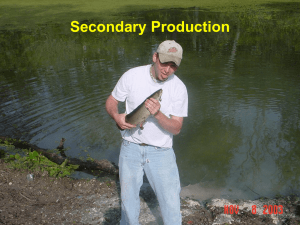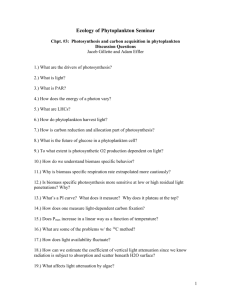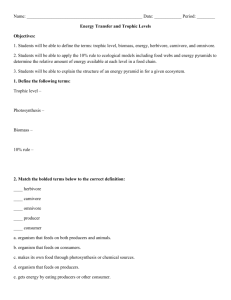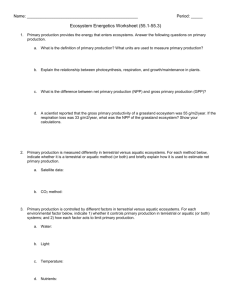AP Biology
advertisement
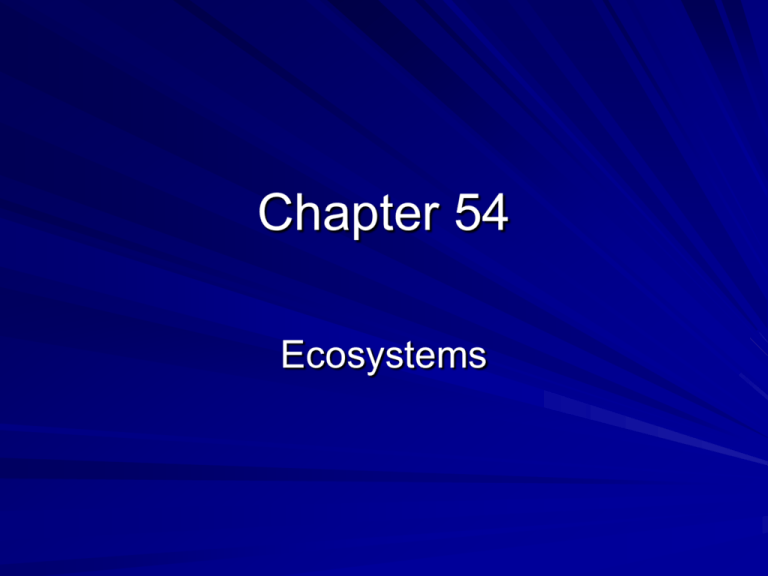
Chapter 54 Ecosystems I. Energy Flow and Chemical Cycling Energy transfer and thermodynamics – Converting energy and energy loss – Chemicals are recycled Trophic relationships – Primary producers – Primary consumers – Secondary consumers – Detritivores/Decomposers LE 54-2 Tertiary consumers Microorganisms and other detritivores Detritus Secondary consumers Primary consumers Primary producers Heat Key Chemical cycling Energy flow Sun II. Limits to Primary Production Gross Primary Productivity (GPP) Net Primary Productivity – NPP = GPP – R – Measured as energy per unit area per unit time or biomass (newly produced) LE 54-4 Open ocean Continental shelf Estuary Algal beds and reefs Upwelling zones Extreme desert, rock, sand, ice Desert and semidesert scrub Tropical rain forest Savanna Cultivated land Boreal forest (taiga) Temperate grassland Woodland and shrubland Tundra Tropical seasonal forest Temperate deciduous forest Temperate evergreen forest Swamp and marsh Lake and stream 5.2 0.3 0.1 0.1 4.7 3.5 3.3 2.9 2.7 2.4 1.8 1.7 1.6 1.5 1.3 1.0 0.4 0.4 0 Key Marine Terrestrial 125 360 65.0 10 20 30 40 50 60 Percentage of Earth’s surface area Freshwater (on continents) 24.4 5.6 1,500 2,500 1.2 0.9 0.1 0.04 0.9 500 3.0 90 22 2,200 7.9 9.1 9.6 5.4 3.5 900 600 800 600 700 140 0.6 7.1 4.9 3.8 2.3 0.3 1,600 1,200 1,300 2,000 250 0 500 1,000 1,500 2,000 2,500 Average net primary production (g/m2/yr) 0 10 15 20 25 5 Percentage of Earth’s net primary production Limitations to NPP In marine and freshwater – Light limitations – Nutrient limitations – limiting nutrients (Fig. 54.6, p. 1189) Eutrophication In terrestrial and wetlands – Actual evapotranspiration LE 54-6 30 5 4 15 11 21 Shinnecock 19 Bay Moriches Bay Atlantic Ocean 2 8 7 6 5 4 3 2 1 0 8 7 6 5 4 3 2 1 0 Phytoplankton Inorganic phosphorus 2 11 3015 19 21 Station number Great Moriches South Bay Bay 4 5 Inorganic phosphorus (µm atoms/L) Phytoplankton (millions of cells/mL) Coast of Long Island, New York Shinnecock Bay Phytoplankton biomass and phosphorus concentration Phytoplankton (millions of cells per mL) 30 24 Ammonium enriched Phosphate enriched Unenriched control 18 12 6 0 Starting 2 algal density 4 5 11 30 Station number 15 Phytoplankton response to nutrient enrichment 19 21 Live, above-ground biomass (g dry wt/m2) LE 54-9 300 N+P 250 200 150 N only 100 Control P only 50 0 0 June July August 1980 Energy Transfer Efficiency Secondary production Production efficiency - % not used for respiration Trophic efficiencies and pyramids – Pyramid of production (Energy) – Pyramid of biomass – Pyramid of numbers LE 54-10 Plant material eaten by caterpillar 200 J 67 J Feces 100 J 33 J Growth (new biomass) Cellular respiration LE 54-11 Tertiary consumers Secondary consumers Primary consumers Primary producers 10 J 100 J 1,000 J 10,000 J 1,000,000 J of sunlight LE 54-12a Trophic level Tertiary consumers Dry weight (g/m2) 1.5 Secondary consumers 11 Primary consumers 37 Primary producers 809 Most biomass pyramids show a sharp decrease in biomass at successively higher trophic levels, as illustrated by data from a bog at Silver Springs, Florida. LE 54-12b Trophic level Dry weight (g/m2) Primary consumers (zooplankton) 21 Primary producers (phytoplankton) 4 In some aquatic ecosystems, such as the English Channel, a small standing crop of primary producers (phytoplankton) supports a larger standing crop of primary consumers (zooplankton). LE 54-13 Trophic level Tertiary consumers Number of individual organisms 3 Secondary consumers 354,904 Primary consumers 708,624 Primary producers 5,842,424 LE 54-14 Trophic level Secondary consumers Primary consumers Primary producers IV. Biogeochemical Cycles See figure 54.18, p.1198 Water cycle Carbon cycle Nitrogen cycle Phosphorus cycle LE 54-16 Reservoir a Reservoir b Organic materials available as nutrients Organic materials unavailable as nutrients Fossilization Living organisms, detritus Assimilation, photosynthesis Coal, oil, peat Respiration, decomposition, excretion Burning of fossil fuels Reservoir c Reservoir d Inorganic materials available as nutrients Inorganic materials unavailable as nutrients Atmosphere, soil, water Weathering, erosion Formation of sedimentary rock Minerals in rocks LE 54-17a Transport over land Solar energy Net movement of water vapor by wind Precipitation over ocean Evaporation from ocean Precipitation over land Evapotranspiration from land Percolation through soil Runoff and groundwater LE 54-17b CO2 in atmosphere Photosynthesis Cellular respiration Burning of fossil fuels and wood Higher-level Primary consumers consumers Carbon compounds in water Detritus Decomposition LE 54-17c N2 in atmosphere Assimilation Nitrogen-fixing bacteria in root nodules of legumes Decomposers Ammonification NH3 Nitrogen-fixing soil bacteria NO3– Nitrifying bacteria Nitrification NO2– NH4+ Nitrifying bacteria Denitrifying bacteria LE 54-17d Rain Geologic uplift Weathering of rocks Plants Runoff Consumption Sedimentation Soil Leaching Plant uptake of PO43– Decomposition LE 54-18 Consumers Producers Decomposers Nutrients available to producers Abiotic reservoir Geologic processes V. Human Disruption on Cycles Nutrient enrichment – Agriculture and nitrogen cycling criticial load in aquatic ecosystems cultural eutrophication Acid precipitation Toxins and biological magnification Rising atmospheric CO2 Depletion of ozone LE 54-21 4.6 4.3 4.6 4.3 4.6 4.1 4.3 4.6 Europe North America LE 54-23 Concentration of PCBs Herring gull eggs 124 ppm Lake trout 4.83 ppm Smelt 1.04 ppm Zooplankton 0.123 ppm Phytoplankton 0.025 ppm LE 54-24 390 1.05 380 0.90 CO2 concentration (ppm) Temperature 0.60 360 0.45 350 0.30 340 CO2 0.15 330 0 Temperature variation (°C) 0.75 370 320 –0.15 310 –0.30 300 –0.45 2005 1960 1965 1970 1975 1980 1985 Year 1990 1995 2000 LE 54-26 Ozone layer thickness (Dobson units) 350 300 250 200 150 100 50 0 1955 1960 1965 1970 1975 1980 1985 1990 1995 2000 2005 Year (Average for the month of October) LE 54-27 Chlorine atoms Chlorine from CFCs interacts with ozone (O3), forming chlorine monoxide (CIO) and oxygen (O2). O2 Chlorine O3 CIO O2 Sunlight causes Cl2O2 to break down into O2 and free chlorine atoms. The chlorine atoms can begin the cycle again. CIO Cl2O2 Sunlight Two CIO molecules react, forming chlorine peroxide (Cl2O2).



